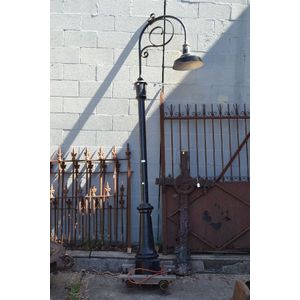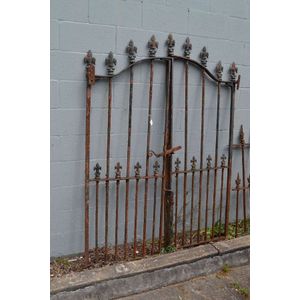Victorian Cast Iron Gate with Fleur de Lis Finials
Antique Victorian cast iron gate with fleur de lis finials, from an old Colonial Federation property, approx 184 cm high, 132 cm total width (2)
You must be a subscriber, and be logged in to view price and dealer details.
Subscribe Now to view actual auction price for this item
When you subscribe, you have the option of setting the currency in which to display prices to $Au, $US, $NZ or Stg.
This item has been sold, and the description, image and price are for reference purposes only.
- Fleur-De-Lis - The fleur-de-lis is a stylized lily or iris flower with
three petals that has been used as a decorative motif for thousands of years. It
often appears in Christian iconography symbolising the Holy Trinity and as an
emblem that reflects the purity of the Virgin Mary. In decorative art and antiques
decoration, the fleur-de-lis is often used as a symbol of elegance, refinement,
and good taste.
The fleur-de-lis has a rich history and in ancient times, it
was associated with royalty, purity, and the divine, and it was used as a
symbol of the French monarchy for many centuries.
It is a common design element in ceramics, silverware, jewellery,
furniture, and other decorative objects, and it can be found in many different
styles and forms. - Federation Period - The Federation style in architecture and furniture is broadly the Australian equivalent of the English Edwardian period and extended from 1890 to 1915. The name relates to Australia becoming a Federation in 1901, when the colonies became the Commonwealth of Australia.
- Finial - An architectural decoration, found on the upper parts of of an object. On furniture they are usually found on pediments, canopies and shelf supports. On smaller ceramic or silver items, such as spoons, they may decorate the top of the item itself, or the lid or cover where they provide a useful handle for removal.
Finials have a variety of shapes and forms. They may be urn-shaped, baluster shaped round or spiral, but usually taper into an upper point. Many real life shapes may also be used as finials, such as pineapples, berries, pinecones, buds, lotus and acorns. Sometimes animals such as a lion are depicted, or fish and dolphins. - Victorian Period - The Victorian period of furniture and decorative arts design covers the reign of Queen Victoria from 1837 to 1901. There was not one dominant style of furniture in the Victorian period. Designers used and modified many historical styles such as Gothic, Tudor, Elizabethan, English Rococo, Neoclassical and others, although use of some styles, such as English Rococo and Gothic tended to dominate the furniture manufacture of the period.
The Victorian period was preceded by the Regency and William IV periods, and followed by the Edwardian period, named for Edward VII (1841 ? 1910) who was King of the United Kingdom and the British Dominions and Emperor of India for the brief period from 1901 until his death in 1910.
This item has been included into following indexes:
Visually similar items

Antique French green painted wrought iron gate, 220 cm high, 104 cm wide
Sold by
in
for
You can display prices in $Au, $US, $NZ or Stg.

Impressive pair of vintage French wrought iron entrance gates, 275 cm high, each 153 cm wide
Sold by
in
for
You can display prices in $Au, $US, $NZ or Stg.

Cast iron support, street light, scrolling metal top bracket with light, approx 300 cm high
Sold by
in
for
You can display prices in $Au, $US, $NZ or Stg.

Selection of antique French Gothic wrought iron pieces, to include gates, 100 cm high each (4)
Sold by
in
for
You can display prices in $Au, $US, $NZ or Stg.
